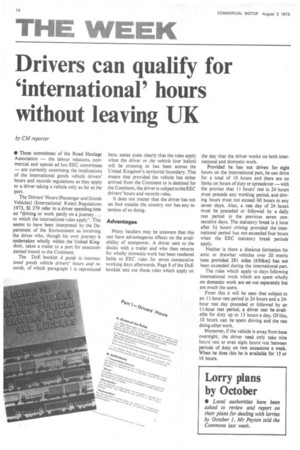Drivers can qualify for 'international' hours without leaving UK
Page 12

If you've noticed an error in this article please click here to report it so we can fix it.
by CM reporter • Three committees of the Road Haulage Association — the labour relations, commercial and special ad hoc EEC committees — are currently examining the implications of the international goods vehicle drivers' hours and records regulations as they apply to a driver taking a vehicle only as far as the port.
The Drivers' Hours (Passenger and Goods Vehicles) (International Rules) Regulations 1973, SI 379 refer to a driver spending time on "driving or work partly on a journey.
to which the international rules apply". This seems to have been interpreted by the Department of the Environment as involving the driver who, though his own journey is undertaken wholly within the United Kingdom, takes a trailer to a port for unaccompanied transit to the Continent.
The DoE booklet A guide to international goods vehicle drivers' hours and records, of which paragraph 1 is reproduced here, states quite clearly that the rules apply when the driver or the vehicle (our italics) will be crossing or has been across the United Kingdom's territorial boundary. This means that provided the vehicle has either arrived from the Continent or is destined for the Continent, the driver is subject to the EEC drivers' hours and records rules.
It does not matter that the driver has not set foot outside the country nor has any intention of so doing.
Advantages
Many hauliers may be unaware that this can have advantageous effects on the availability of manpower. A driver sent to the docks with a trailer and who then returns for wholly domestic work has been rendered liable to EEC rules for seven consecutive working days afterwards. Page 8 of the DoE booklet sets out those rules which apply on the day that the driver works on both international and domestic work,
Provided he has not driven for eight hours on the international part, he can drive for a total of 10 hours and there are no limits on hours of duty or spreadover — with the proviso that 11 hours' rest in 24 hours must precede any working period, and driving hours must not exceed 60 hours in any seven days. Also, a rest day of 24 hours must be preceded or followed by a daily rest period in the previous seven consecutive days. The statutory break is + hour after 54hours' driving provided the international period has not exceeded four hours when the EEC statutory break periods apply.
Neither is there a distance limitation for artic or drawbar vehicles over 20 metric tons provided 281 miles (450km) has not been exceeded during the international part.
The rules which apply to days following international work which are spent wholly on domestic work are set out separately but are much the same.
From this it will be seen that subject to an 11-hour rest period in 24 hours and a 24hour rest day preceded or followed by an 11-hour rest period, a driver can be available for duty up to 13 hours a day. Of this, 10 hours can be spent driving and the rest doing other work.
Moreover, if' the vehicle is away from base overnight, the driver need only take nine hours' rest or even eight hours' rest between periods of duty on two occasions a week. When he does this he is available for 15 or 16 hours.
































































































